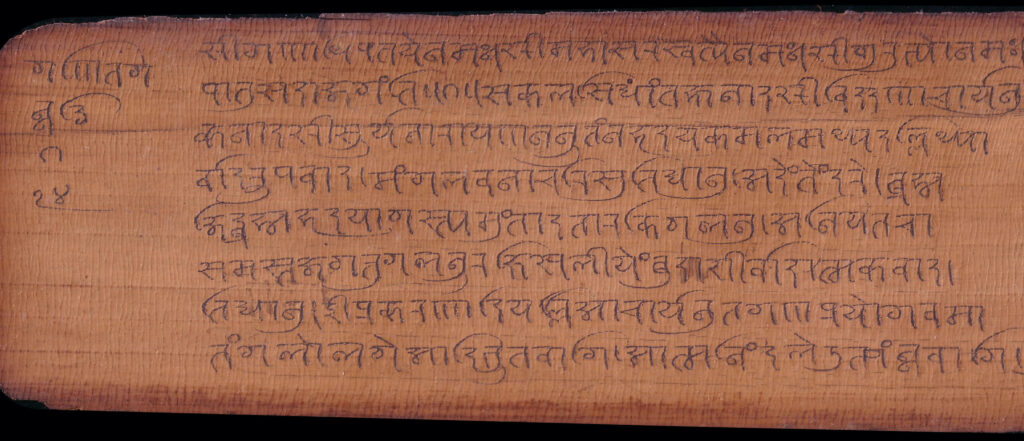
Documented studies detailing the rich history of mathematics and astronomy in ancient India, both by Western and Indian scholars, and most of which have been in Sanskrit language, are well-known. The present article sheds light on the contents of some prominent works in the Kannaḍa language such as the 400 year old Gaṇitagannaḍi as also some more recent 19th century works, highlighted for the painstakingly and meticulously worked out details present in them, thus making a convincing case that for the eager and persevering student of mathematical history, this unexplored domain offers ample potential for study.
It is very well known that astronomy and mathematics texts depicting the rich tradition of India are available in Sanskrit. The earliest record with an unambiguous date is the Āryabhaṭīya of Āryabhaṭa (499 CE). Copies of these texts and their commentaries are available in archival collections, both in India and abroad; the language, by and large, being Sanskrit (see [3]).
That astronomy and mathematics literature existed in other languages came to light when several original texts were discovered in the early 20th century in South India, a major chunk from Kerala. K.V. Sarma, in particular, carried out extensive research in this regard, unearthing important works in Malayalam, apart from Sanskrit. This substantiated a parallel development in different schools such as those in Jaipur, Varanasi, Ujjain, Parthapura, Bid and Vijayapura (see [2]). Sanskrit had earlier caught the attention of many European scholars who then pursued their interest in learning the techniques, and reported them back to the scholarly Societies in France and England. The French astronomer Guillaume Le Gentil, while waiting for the transit of Venus (of 1769) in southern India, even prepared an encyclopedia of the local flora and fauna. He also learnt Sanskrit and astronomical computations from many South Indian scholars (see [8]), at a place called Kishnaporum, between Bangalore and Kanchipuram.
Following the pioneering work of K.V. Sarma, several works from Kerala were reported in the last few decades, the most exciting of which is the citation of Nīlakanṭha Somayāji, from his paramaguru (meaning teacher’s teacher) on a model of the solar system, and its close resemblance to the 15th century model of Tycho Brahe (see [11]). This brought to light the depth of knowledge available then, and also provided a new avenue for searching for texts written particularly after the 12th century. Another school in Gujarat had been flourishing, with Gaṇeśa Daivajña in the lead, around the 15th century (see [1]). The monumental work of Shankar Balakrishna Dikshit (original in Marathi extending to two volumes in the English translation), brings forth the works of many other astronomers (see [4]).
A search for texts on astronomy in regional languages essentially starts with cross-references provided in other forms of literature. Thanks to the efforts of many dedicated scholars, well-prepared catalogues in archival collections are now available. A recent compilation [13] shows that almost 90% of the manuscripts are still to be extracted from their palm leaf originals.
A quick glance at the compilation at the archival libraries unfolds another problem. The category of Jyotiṣa includes the texts of phala jyotiṣa, hasta sāmudrika (palmistry) and śakuna śāstra (the study of ill and good omens). Thus the first step would be to identify and extract astronomy texts after a careful browsing. Fortunately, in some cases, the first verse and the colophon1 are provided. But for the efforts of a small number of scholars who have dedicated their lives to studying these palm leaves, we would have been deprived of the treasures left behind by our ancestors. The best example is that of Arthaśāstra by Kautilya, which was extracted from palm leaves, and translated into English by R. Shamasastry in 1915, which has been a model for several centuries. Chanakya, or Kautilya, has been known to us as a legend for his thoughts on efficient administration. This text, rendered into English, provided a turning point in our understanding of the ancient history and economics of our country.
Gaṇitasārasangraha of Mahāvīrācārya of the 8th century is considered to be an authoritative text (see [10]). It is also known for its poetic rendering. Besides many mathematical aspects, it discusses examples of the use of mathematics in everyday life. Examples include not only calculation of employee wages, or those involving water flows and their usage, but also of losses incurred in routine business transactions; and perhaps on an even larger scale, losses in wars as well. It has even been translated into other languages. The Telugu translation was carried out by Pāvalūri Mallaṇa (see [12]). Further, Sarma cites a series of articles by K.R. Rajagopalan in the issues of the Bhavan’s Journal2 during 1958–59, on mathematical texts from Andhra, Karnataka, Kerala and Tamil Nadu.
The introduction of science and mathematics education in regional languages has been studied by Gurevitch (see [7]), with special reference to the 12th century text on mathematics, Vyavahāra gaṇita, by Rājāditya. He addresses the development of texts for other disciplines of science in Kannaḍa in this context, and elaborates on its “useful knowledge” for contemporary trade and commerce, as inferred from the examples provided therein.
Let us now take a brief survey of Kannaḍa texts available in some of the archival collections.
Collections at the Shruta Kaivali Prakrit Study Centre, Sravanabelagola
This is a collection consisting mainly of Jain philosophical texts. Sannayya has very carefully classified and catalogued them in 10 volumes. The astronomical texts include copies of Tiloyapaṇṇatti (the Prakrit version of Trilokaprajñapti), Sūryaprajñyapti and other shorter texts with tables and incomplete commentaries. There are several copies of certain sections of the work Gaṇitasārasangraha. Some palm leaves of Tiloyapaṇṇatti have pictorial representations too. The popularity of Vyavahāra gaṇita of Rājāditya, discussed above, is attested by the presence of a large number of copies all the way down to the 18th century in this collection.
Collections at the Oriental Research Institute (ORI), Mysuru
The vast collection of palm-leaf and paper manuscripts in this institute have been compiled into several volumes, of which the 9th volume is devoted to Jyautiṣam (see [9]). It includes texts of mathematics and astronomy as well as astrology, palmistry, and even texts related to omens. After a detailed search of the contents in this volume (the compilation was published in 1983), it was found that more than 50% of the manuscripts here were sadly already damaged and not usable. A lion’s share of the texts consists of astrology—multiple copies of Jātaka paddhati, Jātakālankāra, Muhūrta cintāmaṇi and the like.
There are 49 copies of Līlāvati of Bhāskarācārya and 11 commentaries on it in various languages, in scripts such as Telugu, Grantha, Nandināgari and Devanāgari, apart from Kannaḍa. 35 manuscripts of the Sūryasiddhānta and 6 commentaries on it are also available in these languages. There are many copies here of the Siddhānta Śiromaṇi and Grahalāghava – some with commentaries. Whether the commentaries are in these languages or in Sanskrit—with the possibility of the script being in a third language—will be known only when one opens and reads a few leaves.
The Museum at Keladi, Sagara
This museum started as a personal collection of Keladi Gunda Jois and evolved into dimensions unmanageable for him as an individual. Most of the manuscripts were collected by him via a door-to-door campaign. There are copies of Grahalāghava in this collection. There are many copies of texts on astrology. Some of the manuscripts pertaining to astronomy and mathematics, though small in number, are quite intriguing. There is one exclusively on geometry by an unknown author, yet to be deciphered. The other is a tabulation of numerals (by an unknown author)—a close observation reveals that they are multiplication tables, called maggi in Kannaḍa, up to 20 \times 20.3 The tabulation includes squares of numbers, units of currency (rupāi, āṇe, kāsu), distance, weight and volume. A preliminary report was published by Keladi Gunda Jois in a Kannaḍa journal.
A severe handicap in the study of these manuscripts is their accessibility. Though a small fraction has been rendered into digital online versions, there are thousands lying untouched and not easily accessible. All texts older than the 17th century use either grantha or nandināgari. Today, only a handful of scholars are able to read these scripts. The other extinct script is Tigaḷāri, for which, fortunately, an exhaustive guide has been written by Keladi Gunda Jois (see [6]). The scholars who will need these trans-literary guides are historians and epigraphists, both of whom operate outside the domain of mathematics. An interdisciplinary study is the need of the hour, so that all these valuable texts are brought to light before the leaves are rendered completely useless by natural decay processes. It is also urgent since more and more inscriptions are being unearthed, and more manuscripts from family heritage collections are surfacing.
Let us now discuss some of the texts of astronomy in Kannaḍa from different epochs.
Śukragrasta sūryagrahaṇavu (The Transit of Venus) by Chintamani Ragoonathacharry.
Chintamani Ragoonathacharry (CR) (anglicized form of Chintamani Raghunatha Acharya, 1828–1880) was one of the first Indians to study and practise European procedures of observational astronomy. He worked at the Madras Observatory, and was one of the very few Indians to be nominated to the Royal Astronomical Society (RAS). His work was appreciated by N.R. Pogson, the then Director of the Madras Observatory (see [15]):
The discovery of a variable star `R Ret’4 is credited to him. CR was experienced in traditional Indian, as well as modern, astronomy. The transit of Venus in 1874 provided him with an opportunity to reach out to common people. Three versions of a monograph related to the 1874 Venus transit, the solar eclipse of 1868, and an occultation5 were published by CR in three different languages—in English, Kannaḍa and Urdu—addressed to different categories of readership. The aim was to educate traditional Indian astronomers so that they take up observations seriously. He included three celestial events and requested his readers to observe the solar eclipse of 6 April 1875, the Venus occultation of 12 November 1874 and the conjunction6 of Jupiter and Mars in December 1874. In his Urdu monograph he writes:
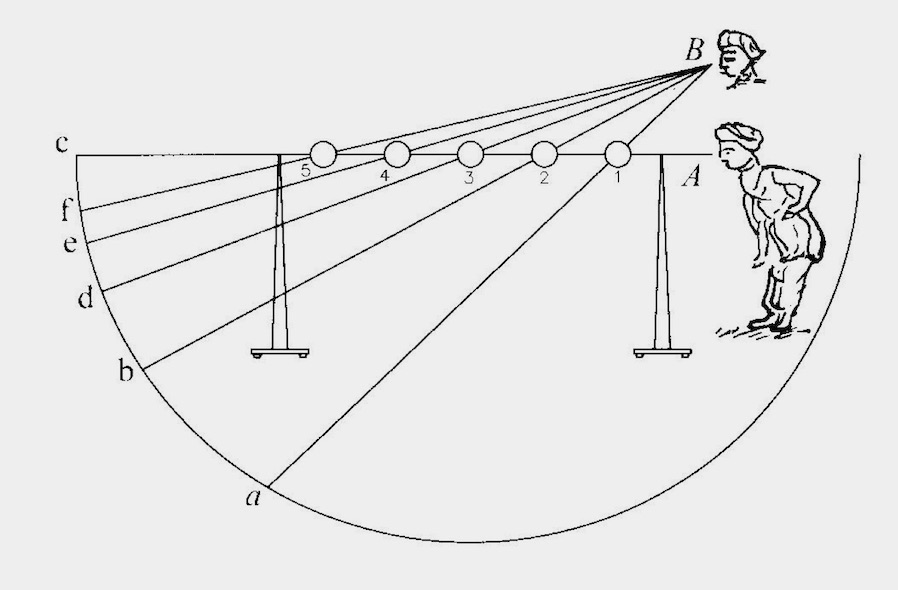
The lucid monograph of CR introduces to the reader the meaning of transit, and the need for its observations. It has excellent drawings, perhaps prepared by the author himself. This can be considered remarkable progress since all the texts on mathematics or astronomy of the earlier period did not have any drawings, although a chapter called parilekhana was dedicated to it.
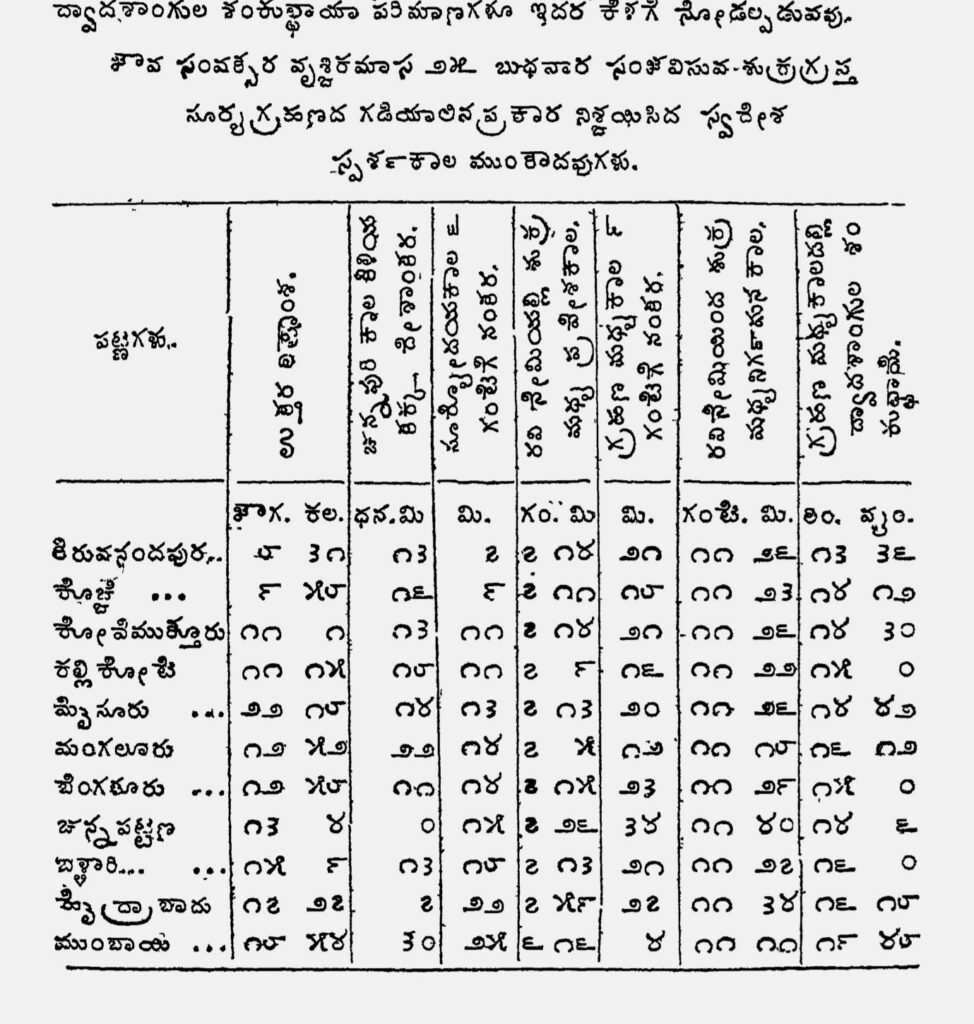
What distinguishes the Kannaḍa text from the other two is the last chapter, which addresses local pundits. This also gives an insight into the practical details of the method of observations of contemporary Indian astronomers. The table listing the timings provides the shadow lengths (of a 12” gnomon) for different towns like Tiruvananthapuram, Kallikote (Calicut), Chennapattana, Madras (Chennai) and so on. He cites several contemporary scholars like Bapudeva Sastri with whom he had corresponded. He particularly refers to the work of Saint Madhvacharya (of Udupi) with great reverence (prompting one to speculate that he perhaps belonged to the Madhva sect of Brahmins).
This manuscript (a copy of it, actually, and without a cover page) is preserved at the archival collections of the Indian Institute of Astrophysics, which itself traces its origin to the now 235 years-old Madras Observatory.
Another monograph on the total solar eclipse of 1871 is available in Kannaḍa at the Adyar Library in Chennai. One is likely to miss this in a search for astronomy texts, since it is catalogued under `Literature’ as a Purāṇa text. The correct title Pūrṇa sūrya grahaṇa vivaravu, erroneously catalogued in English as ‘purāṇa sūrya graha vicāravu’, misleads the reader. Its digital version is available online. It is a comprehensive report on the eclipse of 1871.
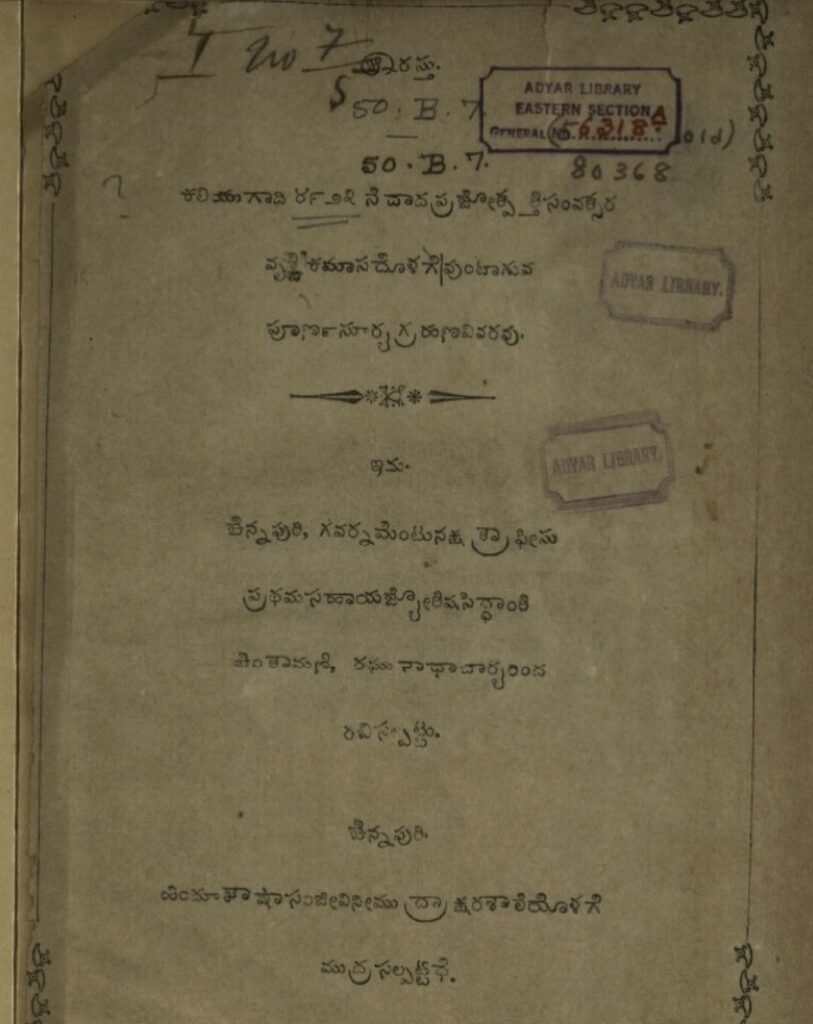 |
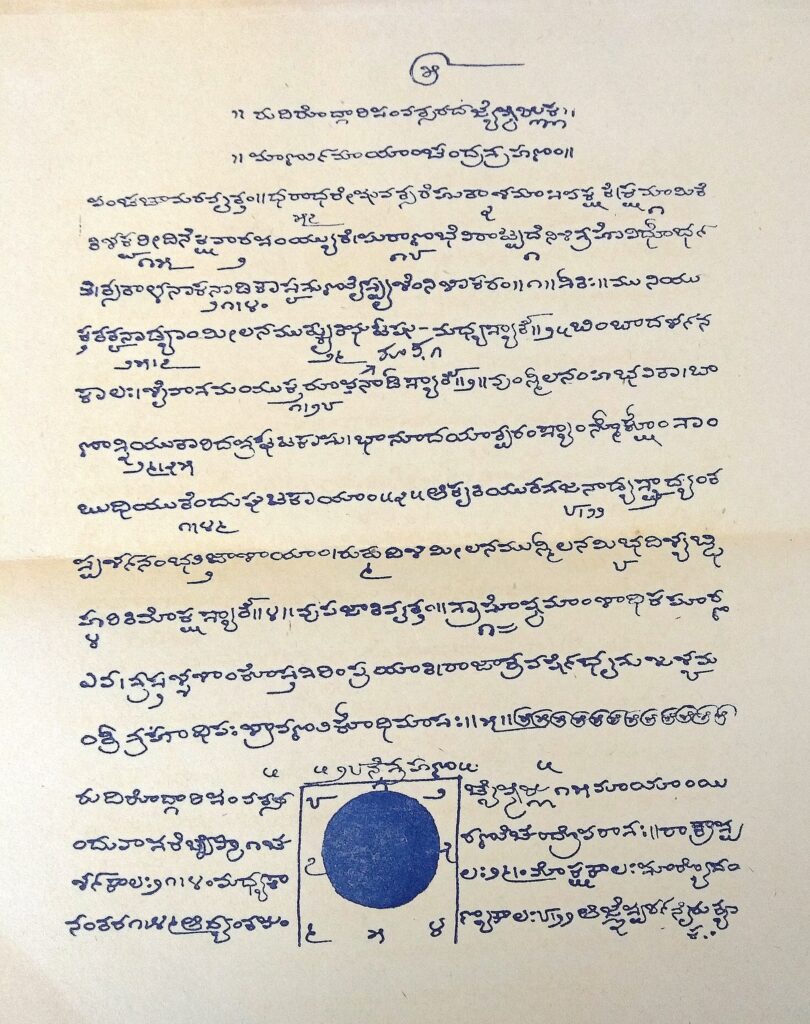 |
Grahaṇa darpaṇa by Chaturanga Anantaraje Arasu (19th century).
A canon of eclipses of 100 years (1800 to 1900), called Grahaṇa darpaṇa, was published from Mysuru. It was under the directive of king Mummaḍi Krishnaraja Wodeyar7 to the author, who was a scholar in both Sanskrit and Kannaḍa. The family lived in Talakāḍu on the banks of river Kāveri, a place well known for the mysterious accumulation of sand, and which drove a few families out of the village. Chaturanga Anantaraje Arasu moved over to another village, and subsequently to Mysuru. In his old age, he moved to his sister’s village Kallahalli and spent his last days teaching. He submitted this manuscript to the king in 1863, as stated in the preface. The amazing feat of the book is not just the compilation, along with timings and pictorial representation of eclipses visible from Mysuru, but the extensive use of the bhūtasankhya system8 to depict the timings of the eclipses. A compilation of all the numerals in this system from this book would become a valuable reference for scholars, since a majority of the texts (not only in Kannaḍa, but in other languages too) use the bhūtasankhya notation extensively. The verses are composed in Sanskrit, but the entire book is written in the Kannaḍa script. The introduction renders the explanation of the text in Kannaḍa, making it user-friendly. It also assumes that the reader is quite knowledgeable about the technical terms occurring in the calculation of eclipses.
The original manuscript, which was available for perusal till 2009 at ORI, Mysuru, had drawings of the eclipses in colour. Subsequently, the grandson of the author decided to reprint it providing all the details of the author, which was missing in the copy at ORI.9 It is likely that the monochrome reproduction of drawings may not have some intricate details of the original coloured drawings, although the colour coding is not explicitly stated anywhere.

Gaṇitagannaḍi (Mirror of mathematics)
This manuscript, obtained from the collection of Kulapati Śankaranārāyaṇa Joyisaru of Śṛngeri, is a commentary on an earlier work, Vārṣikatantra. The verses are in Sanskrit and commentaries are in Kannaḍa, both written in nandināgari script on palm leaves. The family has taken great care and has preserved them very well for over 400 years. The original text Vārṣikatantra was written by Viddaṇācārya, a very well known astronomer, and the son of renowned astronomer Mallaṇācārya.
The karaṇa text (manual or handbook) Gaṇitagannaḍi was completed on Śālivāhana śaka 1526 Krodhi Samvatsara Bhādrapada bahula 12 somavāra (10 September 1604) as per the colophon. The chapters are arranged as in any Hindu astronomy text. It begins with a long introduction, along with a brief mention of the family of the great Acārya Viddaṇācārya. Both the works of Śankaranārāyaṇa Joyisa, namely Tantradarpaṇa (1601 CE) and Karaṇābharaṇam (1603 CE) have the colophon “… composed by Śankaranārāyaṇa Joyisa, the son of Dēmaṇa Joyisa, the astronomer, a resident of Śṛngapurī, who is equivalent to Brihaspati, the guru of Indra”. The entire lineage from 1500 CE has been traced by Seetharama Javagal, who was instrumental in bringing this to light from the palm leaf manuscripts in his grandfather’s collection.
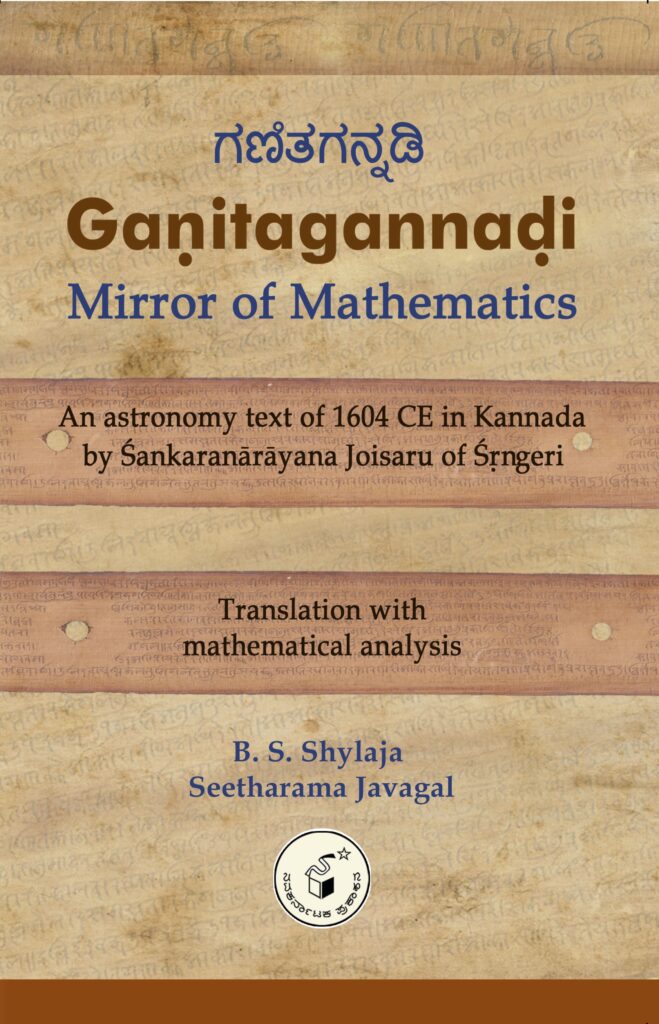
The chapter called Parilekhana describes a graphical method for obtaining the timings, magnitudes, and points of ingress, right up to minute details on fixing the scale, and related measurements. This procedure suggests the reversal of directions needed to match drawings in the book with the view in the natural sky. We infer that the author was well acquainted with the preparation of drawings suitable for observations.
The subsequent chapters, Pātādhyāya and Udayāstamaya, and the other called Grahasamāgama are very brief. The last chapter on Śṛngonnati describes the determination of the elevation of the cusps of the crescent moon, and even presents a diagram to depict the orientation. The procedures are explained in very crisp Kannaḍa sentences.
With Gaṇitagannaḍi as a manual, observations can be converted into the quantities needed for calculations. In the third chapter, we see that the entire scheme of calculations is centred around the shadow length of the gnomon12 for the day. All the other formulae are derived with the values of dyuniśārdha karṇa, viṣuvat karṇa and viṣuvat chāyā,13 with other constants for the given location and given date. The standard corrections are tabulated for Sringeri.
Emphasis is laid on the process of iteration (asakṛt) for obtaining better values. We get to know that it was a standard procedure from another source Brahmatulya Udāharaṇam of Viśvanātha of the 16th century, where the longitude of Mars is obtained after 7 iterations [14].
Events like occultations and conjunctions are explained with minute details, such as the scaling-down for drawings and the sense of direction.
As mentioned earlier, the script used for both the languages in Gaṇitagannaḍi is nandināgari. Therefore, the first step was to rewrite them in Kannaḍa and Devanāgari scripts, as applicable. This was achieved by Seetharama Javagal, who learnt the script and rendered the entire text to Unicode fonts [16].
It would be interesting to study the evolution of such texts of astronomy in Kannaḍa, with the very first example being offered by Gaṇitagannaḍi. Let us hope that a search begins for such treasures not only in Kannaḍa but in other regional languages too, whose pages are waiting for centuries to be unfolded and read.
Acknowledgements: The author is grateful to Professor S.R. Sarma for very useful comments. \blacksquare
References
- S. Balachandra Rao and S.K. Uma, Grahalāghavam of Gaṇeśa Daivajña: An English exposition with mathematical explanation, derivations, examples, tables and diagrams, Indian Journal of History of Science, Supplement, 41 (3), S185-S315, 2006.
- S. Balachandra Rao, Indian Mathematics and Astronomy – Some Landmarks (Revised Third Edition), Bharatiya Vidya Bhavan, Bangalore, 2012.
- S.G. Dani, Ancient Indian Mathematics: An Overview,
https://www.tifr.res.in/~archaeo/FOP/FoP%20papers/ancmathsources_Dani.pdf, 2011. - S.B. Dikshit, Bhāratiya Jyotihṣṣātra (in Marathi), Poona 1896; reprinted, Poona 1931; English Translation by R.V. Vaidya, History of Indian Astronomy, Part I: History of Astronomy during the Vedic and Vedanga Periods, Delhi 1969; Part II: History of Astronomy during the Siddhantic and Modern Periods, Delhi 1981.
- N. Kameswara Rao, A. Vagiswari and Birdie Christina, Early pioneers of telescopic astronomy in India: G.V. Juggarow and his observatory, Current Science, 100, 1575-1581, 2011.
- Keladi Gunda Jois, Tigalari Script, Keladi Research Foundation, Sagara, Karnataka, 2016.
- Gurevitch, Eric Moses: The Uses of Useful Knowledge and the Languages of Vernacular Science: Perspectives from Southwest India, History of Science, Vol 59, No. 3, 256-286, 2020.
- Hogg, Helen Sawyer: Out of Old Books – “Le Gentil and the Transits of Venus, 1761 and 1769”, Journal of the Royal Astronomical Society of Canada, Vol 45, p37, Feb 1951.
- H.P. Malladevaru, Descriptive Catalogue of Sanskrit Manuscripts, Volume 9, Oriental Research Institute Series, 140; University of Mysore, 1983.
- Padmavatamma, Gaṇitasārasangraha of Mahāvīra, Original text with Kannaḍa and English translation, Siddhanthakirthi Granthamala of Sri Hombuja Jain Math, Shimoga District, Karnataka, India, 2000.
- K. Ramasubramanian, M.D. Srinivas and M.S. Sriram, Modification of the earlier Indian planetary theory by the Kerala astronomers (c. 1500 AD) and the implied heliocentric picture of planetary motion, Current Science, 66, 784-790, 1994.
- S.R. Sarma, Mathematical Literature in Regional Languages, in Ancient Indian Leaps into Mathematics, eds. B.S. Yadav and Man Mohan, Birkhauser, 201-211, 2011.
- M.D. Srinivas, The Untapped Wealth of Manuscripts on Indian Astronomy and Mathematics, Indian Journal of History of Science, Vol 54, No 3, 243-268, 2019.
- B.S. Shubha, Brahmatulya Udāharaṇam, Thesis for fulfillment of Doctoral degree requirements, Samskrita University, Bengaluru, 2020.
- B.S. Shylaja, Chintamani Ragoonathacharry and Contemporary Indian Astronomy, Navakarnataka Publications, Bengaluru, India, 2012.
- B.S. Shylaja and Seetharama Javagal, Gaṇitagannaḍi: A Mirror of Mathematics, Navakarnataka Publications, Bengaluru, 2021.
Footnotes
- A colophon is a short statement that informs the reader about certain key details of a book, such as the date of compilation, name of the author etc.; if it is a translation then the name of the translator is mentioned. Typically, it is present at the end of the work. ↩
- Bhavan’s Journal is an English fortnightly, devoted to life, literature and culture, started in 1954 by K.M. Munshi, and published by Bharatiya Vidya Bhavan. ↩
- One usually stops at 20 \times 10. Here, it proceeds to 20 \times 11, 20 \times 12 etc. up to 20 \times 20. Similarly 19 \times 11, 19 \times 12, 18 \times 11, 18 \times 12 etc. are there. ↩
- Stars are named alpha, beta etc. in the decreasing order of their brightness, in any constellation. Alpha Ari is the brightest in the constellation Aries. For variable stars though, the convention is to start with the letter P. For example, P Cyg is the first variable star discovered in the constellation of Cygnus. Thus, R is a variable star’s `catalog number’ and Ret is the name of the constellation, `Reticulii’. ↩
- The phenomenon of the moon covering a planet or a star. ↩
- The phenomenon of two planets approaching each other within a very small angle, seemingly touching each other. ↩
- In Kannaḍa, Immaḍi refers to II, Mummaḍi to III and Nālvaḍi to IV. Hence Mummaḍi Krishnaraja Wodeyar refers to Krishnaraja Wodeyar III. ↩
- Bhūtasankhya system is a method of recording numbers, especially in verses, using ordinary words having cultural connotations of numerical values. For example, the word `netra’ or Eye is used for the numerical value 2. There can be multiple choice of words for the same number, such as `aśvini’ or twin, also used to denote the numerical value 2. ↩
- The ORI now offers this reprinted version of 1972 to its readers. ↩
- Ahargaṇa is the number of days elapsed from a certain epoch to a date under consideration. Knowledge of Ahargaṇa facilitates easy conversation of dates between the calendars and also comparison of dates marked in different calendars. ↩
- Kalivarsha is a time measure starting from approximately 3110 BCE. ↩
- Gnomon is the projecting piece on a sundial using which one reads the time by the shadow it casts. ↩
- `dyu’, `ni\’sa’, `ardha’, `viṣuvat’, `chāyā’ and `karṇa’ respectively, are day, night, half, equinox, shadow and hypotenuse. `viṣuvat chāyā’ is therefore the shadow of a standard 12″ gnomon, measured at noon, at a particular latitude, on equinox. The dynamically changing length of the gnomon’s constantly moving shadow on the ground, estimated via simple trigonometric relations involving hypotenuses, represents the passage of time. ↩
